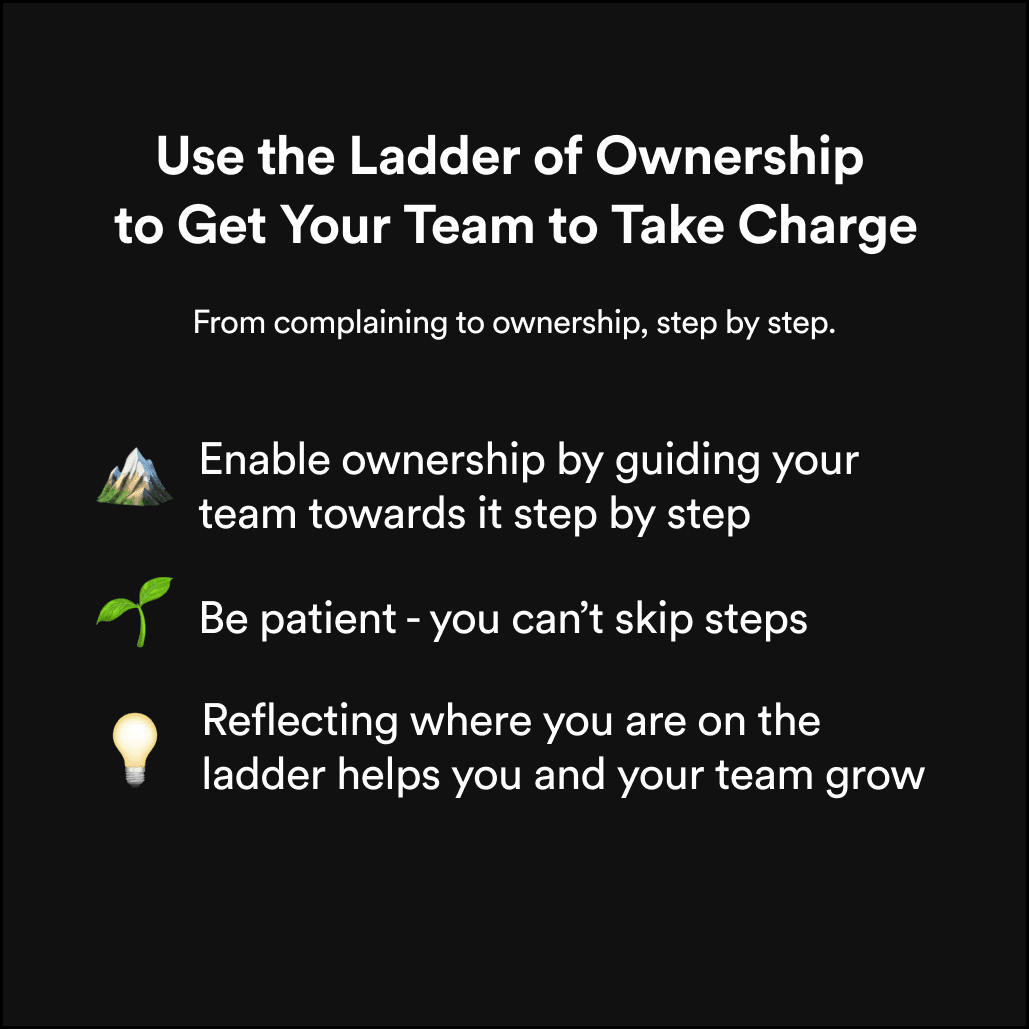Use the Ladder of Ownership to Get Your Team to Take Charge
From complaining to ownership, step by step

Inspired by:
Julie Zhuo, author of The Making of a Manager

🪜 The Ladder of Ownership
Your team seems frustrated and stuck in complaint mode. Nobody is stepping up to find a solution.
Julie Zhuo, author of The Making of a Manager, offers an actionable way to help your team take charge.
🏋️♀️ Guide them to step up
Let’s imagine your team is quiet during meetings. It feels like they're not really present, and no one is making suggestions on what to improve.
You can use the Ladder of Ownership to reengage your team and help them be part of the solution.
⚖️ Level 1: Judging
You can tell from their body language that they’re thinking:
This is the worst! Why am I even wasting my time in this meeting?
It's easy to get defensive here, but try to stay open. Judging means they noticed something that needs improvement, and that’s good!
⚖️ Level 1: Judging
Follow up by saying:
Why don’t we skip this check-in meeting tomorrow? Things seem good for now and we can get back into it on Wednesday.
Even if you feel that the check-in is necessary, try to give space and then find out where the pushback is coming from. That's your next step!
🤫 Level 2: Gossiping
In the meantime, you know they’re talking to each other about it:
These meetings are a waste of time!
Gossiping isn’t optimal, but getting validation from their peers may be their way of coping. Of course, you also want your team to share openly with you. Approach them individually and ask an open-ended question:
Do you have any feedback about our meetings that you’d want to share with me? I want to make sure we’re using our time as effectively as possible.
🤲 Level 3: Giving feedback
Your team member shares their thoughts, but they’re still feeling annoyed:
Yeah, I wish we didn’t have to spend so much time explaining what we’re doing.
They haven’t worked through their feelings about it yet, but that’s the next step. Listen actively, validate their feelings, and ask for more information:
I can understand that. What is the thing that bothers you most about it?
🔮 Level 4: Going deeper
When they go deeper and let you know more, it’s a sign that you’ve won their trust:
Stopping to explain our progress interrupts our workflow, and we can’t get as much done.
This is great information! Then guide them to take the next step themselves. Ask:
If you could do anything about this, what would it be?
👯♀️ Level 5: Collaborating
If they’re ready to move forward, they’ll make a positive suggestion:
What if we did the meeting only once a week?
This is their first chance to be proactive, so work with their suggestion. This helps keep them engaged and motivated. Find a compromise or agree to run an experiment:
Yeah, this may be a good way forward! We could give this a try for 1 or 2 weeks and then evaluate, and keep it or maybe meet twice a week? Could you collect some feedback from the team?
🎢 Level 6: Driving
The next day, hopefully your team member gets back to you, or you might need to follow up with them:
We suggest a 45-minute weekly meeting to review our progress, and the best time for everyone would be Tuesday morning.
This is great progress, it means they are starting to create their own solutions. Keep the momentum:
Sounds good! Are there other things we could do, so that the team can work more effectively?
🏡 Level 7: Owning
Encourage them to share their solutions and come up with new ideas regularly:
We want to collect questions before the check-in, and we decided to add a quick stand-up on Friday afternoons to align for the next week.
At this point, they are truly owning the outcome of their work. Make sure to let them know how grateful you are:
It’s amazing how much you’ve grown this year. It’s so great for the whole team and it makes my job easier when I know I can count on you.
📆 Be patient
Don’t try to get people to jump straight up the ladder. You have to guide them step by step. Talk to your team members individually or as a small group.
Keep reminding yourself:
Where can I give them a little more space to move up? What’s the next question I can ask so that they own the solution themselves?
Remember that you’re all in this together. One small step up the ladder can be a giant leap in validation, for them and for you!
